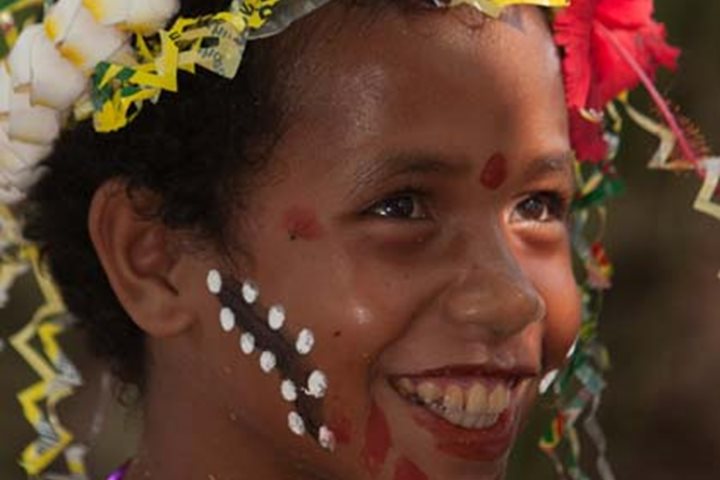Orangerie Bay is known as a gathering place during certain times of the year for whale sharks, the biggest fish in the sea. As luck would have it, October is one of those times. Although we kept a watch during our transit of the bay this morning, none was seen. We did, however, spot numerous sea birds, schools of small fish, and several floating coconuts. The rugged coastline and jagged islets off our port side, as well as occasional views of reefs on both sides of our vessel, showed us why these were considered very treacherous waters for sailing ships in the days before accurate charts were produced.
We arrived at our anchorage midway between Samarai and Deka Deka Islands soon after lunch. Everyone had an opportunity to visit both islands, or if they preferred, they could spend the afternoon on just one. Most people started off on Samarai, in order to witness some welcome dances. Typical of islands in Melanesia, this involved an impressive warrior’s display of jumping around and yelling in a threatening manner. Essentially, this “welcome” was originally designed to demonstrate to visitors that the locals can easily kill you if they want to, but instead have opted to do trades, etc. Nowadays, trading was done. Even though we read about the history of Samarai before arrival, it’s hard to imagine today that Samarai Island was once a bustling trading port and resupply center for ships travelling between Australia and the China. In fact, this tiny island was once the capital of the Milne Bay Province and held the second largest city in Papua New Guinea.
The town, now in ruin, once held attractive colonial buildings, churches, stores, a hospital, schools, waterfront warehouses, hotels and inns, beautiful homes, a cricket field, and even a movie house. Today’s photos show a before and after comparison of the Anglican Church. At the onset of the War in the Pacific (1941 to 1945), Samarai was evacuated and many of the buildings were dismantled or purposely destroyed, so invading Japanese forces could not simply move in to a perfectly good town. As it turned out, Japanese forces didn’t make it to Samarai, but when the war ended, Samarai never regained its earlier importance. The provincial capital was moved to Alotau on the New Guinea mainland and Samarai was nearly forgotten. Life is much slower paced nowadays and the people who live here are decidedly poor. Many of the houses seem somewhat dilapidated, but it was interesting to note that the majority of trees and shrubs give forth healthy foodstuffs, including coconuts, breadfruit, papaya, mangoes, tropical almonds, guava, citrus, pandanus, taro, noni fruit, cassava or manioc, sugar cane, etc., and fish are free for the taking just offshore. So, in spite of the poverty, the populace appears very healthy and happy.
The other afternoon option was a visit to the nearby little island known as Deka Deka. Here, many of us enjoyed a pristine tropical island paradise with a magnificent beach, and in addition to beach combing and enjoying nature along the white sand beach, we also had a chance to enjoy swimming, and snorkeling directly from the beach.







